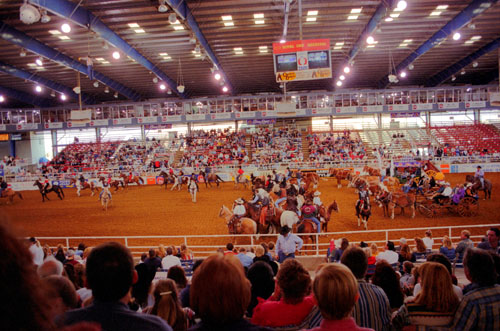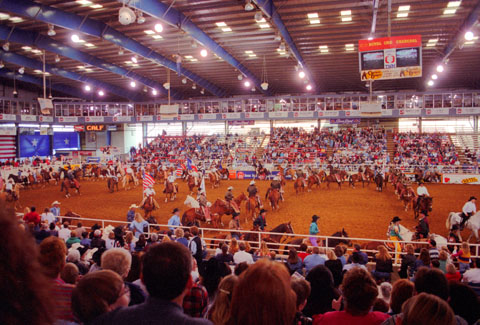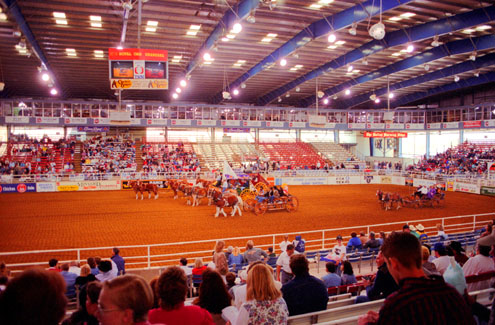


 |
April 2-12, 1996: A Visit Home to North Carolina |
 |
March 24, 1996: A Visit to the Dallas Arboretum |
 |
Return to the Index for 1996 |
Today, Mike Racke, Fred and I are going to the Mesquite Rodeo. The actual reason for going is so Mike can introduce his friend, Dale, who is visiting him from Arizona, to the rodeo, as well as to us. We had heard a lot about Dale, and were happy to meet him for the first time.
|
Getting to the rodeo was pretty straightforward; although it is about 14 miles from my house. A quick trip down the Tollway and onto I-35E, through the "mixmaster" and onto I-30 east- it's the same way I drive to Florida when I go down there. Except for the rodeo we get off of US 80 on I-635, head south two exits and then get off on Rodeo Drive.
The original site of the Mesquite Rodeo was the Charlie McNally's Arena which was located on Hickory Tree Road, a little to the north of present Rodeo Drive. The original Mesquite Rodeo dates from about 1946 but was preceded by the Pleasant Mound Rodeo which began in 1941, also started by Charlie McNally. It was located on the northeast corner of Buckner Blvd and Scyene Road. It was closed when the City of Dallas annexed Pleasant Mound in 1950 and refused to issue a special zoning permit to the rodeo.
|
In 1985, ground was broken for the Mesquite Arena, a new facility for the Mesquite Rodeo, located near Interstate 635 and Scyene Road. Beginning this year, 1997, the facility was undergoing a planned expansion that will bring a new Convention Center, Exhibition Hall and a Hampton Inn & Suites- all facilities you can see in the aerial view from 2014.
(By 2001, attendance had grown to 200,000 during the season, and in 2009, a group of investors purchased the Mesquite Championship Rodeo. They remodeled and refurbished the arena and it was then renamed "Resistol Arena" after the Resistol hat company purchased the naming rights.)
At the Mesquite Rodeo
|
 |
The opening ceremonies featured a long follow-the-leader line of horses and riders that circle in and out of the arena. It's pretty good when it first starts, but then the line inevitably begins to bunch up in places, and by the time the last riders are coming through it looks like stop-and-go on the freeway. On this particular day, I thought the rodeo was rather lightly-attended. Here are a couple more views of the opening ceremonies:
 |
 |
I would have liked to get some good pictures of the actual rodeo events. We stayed for a couple of hours so we got a chance to see a lot of them. The problem was that only with Fred's telephoto lens could you get close enough to make out the action, but the light inside the arena was just not good enough for the use of that lens. We took four or five pictures anyway, but none of them turned out well enough to include here.
But the rodeo was interesting, and talking with Dale was too. It did seem to me as if every square inch of the rodeo building itself, and the clothes worn by the contestants and staff was covered with the logos of just about every product that could possibly be associated with a western event. I think that NASCAR is only a close second in the variety of advertising space that is sold. After the first half of the rodeo, Randy Travis made an appearance, but we just listened to a couple of songs and then left. Fred let me try to get some shots of Travis with the long lens, but they didn't turn out well enough to include here either.
At Pioneer Plaza: The Longhorns
So it is a bit unusual that one of the centerpieces of downtown Dallas is Pioneer Plaza and its longhorn sculptures.
|
The land on which the plaza sits, once railroad and warehouse property, was originally cleared for the failed Griffin Square development, which was to have featured a new hotel and a 55-story office tower. The cleared land sat unused for some time before real estate developer Trammell Crow got the idea for a public park. Hed had for some time wanted an iconic "Western" sculpture in the city of Dallas (not, apparently, listening to the citizens of Fort Worth) and assembled a group to donate the sculptures.
The $9 million project was begun in 1992 on the 4.2 acres donated by the City of Dallas; $4.8 million of the cost came from private funds raised from individuals and local businesses. Local artists sued to stop the project and claimed that it was historically inaccurate for the city, but the project was not derailed and the plaza opened in 1994.
Today the park is maintained by the adjacent Dallas Convention Center (formerly Reunion Arena) and is the second most visited tourist attraction in downtown Dallas. As a work in progress, an additional steer is occasionally added to the herd.
|
The 49 bronze steers and 3 trail riders sculptures were created by artist Robert Summers of Glen Rose, Texas. Each steer is larger-than-life at six feet high; all together the sculpture is the largest bronze monument of its kind in the world. Set along an artificial ridge and past a man-made limestone cliff, native landscaping with a flowing stream and waterfall help create the dramatic effect.
It is really a nice place to come visit, and you can click on the thumbnail images below to see some additional pictures of the longhorns, the trail riders and us. I might point out that I had brought my cowboy hat with me to the Rodeo, although it didn't seem appropriate to wear it there. But since I had it with me, I put it on for some of these pictures. I kind of wished I hadn't, for I was the only person wearing one and it made me look like even more of an urban cowboy.
 |
I've read some criticisms of the whole sculpture, including one that says this cowboy is dressed wrong, has the wrong saddle, and wouldn't be caught dead in the awkward position in which he's been placed.
I think that Dale was suitably impressed with the sculpture and the setting, but I know that the other three of us had been here before. We were aware of the historical "stretching of the truth" that the sculpture represents, and Dale may have been too, although he didn't say so.
We also stopped by the fountains at the Allied Plaza, but it was too chilly to stay there long and too dark for good photographs. For dinner, the four of us went to El Fenix over on Lemmon Avenue near the house, and later we went out to The Roundup for a while. Meeting Dale was interesting; perhaps he will become a central focus for Mike, but I think more probably the distance will be a problem.
You can use the links below to continue to another photo album page.
 |
April 2-12, 1996: A Visit Home to North Carolina |
 |
March 24, 1996: A Visit to the Dallas Arboretum |
 |
Return to the Index for 1996 |